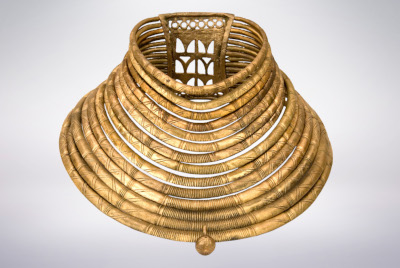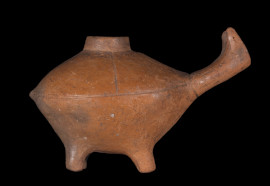Exhibitions
Departments
Residents of fortified enclosures, warlike Scythians
The growth of metallurgical centres in areas abundant in deposits of metal ores combined with a strong demand for bronze goods resulted in wider trade contacts between different peoples. This, in turn, made Europe considerably more culturally homogeneous in the Bronze Age. The changes can be seen especially in beliefs and funerary rites. The spreading custom of cremating human remains, originating from the middle Danube drainage, conquered almost the whole of central Europe in a short time. In the lands of today’s Poland, it is associated with the rise of the Lusatian culture from about 1400 BC. The culture derives its name from the region of Lusatia (between the Elbe and Oder rivers) where the first finds of this kind were made. In the lifetime of the culture, around the middle of the 7th century BC, a new metal appeared – iron, which reached Wielkopolska from the Danube and Rhine drainages. The acquaintance with the new material did not bring initially any significant economic changes as it was used more for making ornaments than for producing implements or weapons.
In Greater Poland, the populations of the Lusatian culture built fortified enclosures or strongholds in places that were naturally easy to defend. For this purpose, islands, pieces of dry ground in the midst of swamps or peninsulas protruding into lakes, rivers, or water-logged meadows were chosen. One of the most famous of such defence settlements from those times is Biskupin, Żnin district. The settlement was founded between the years 737-738 BC. It had about 100 houses whose gable walls adjoined each other and which stood along 11 perpendicular streets, connected by a circular street running along the rampart. On the outer side of the rampart, there was a breakwater, barring access to the stronghold from the lake and protecting the rampart from being damaged by waves.
Different weapons were used in battle, with most of them being still made of bronze in the Early Iron Age. A warrior in those times could be armed with a bow with arrows, a javelin, a sword carried in a wooden or leather sheath, a poleaxe, and an axe. The warrior shown in the exhibition is holding a bronze sword and at his waist, we can see fastened a bronze axe with a wooden haft. He is dressed in thick leather armour and has a leather shield to protect himself. Leather, owing to its strength (it is not easily pierced or cut), was best for making such objects, unlike less strong bronze shields.
As in the Early Bronze Age, in the times of the Lusatian culture hoards hidden by their owners were quite frequent. Only in Greater Poland, several dozen such deposits have been discovered, with most of them dating back to the Decline Bronze Age. The hoards comprised mainly ornaments and tools; weapons and bronze vessels were rather rare. The richest hoards include those presented in the exhibition. They were found in Poznań-Starołęka, Rosko, Czarnków district, and Uścikówiec, Oborniki district.
In the Lusatian culture, some Neolithic traditions had survived as well. They may be illustrated by stone hammer-axes found in the settlements and graves from those times.
In Witaszkowo, Gubin district, a discovery was made of the so-called gold Scythian hoard. Its replica can be seen on the display. We have here a fitting of a short dagger, a fish-shaped fitting of a shield or gorytos, a quatrefoil disc that may have been an element of a horse harness, two necklaces, a surround of a whetstone, and a pendant fragment.
Among artefacts dating back to those times, there are objects possibly related to magic such as clay rattles that may have been used during funerary rites. It seems that the cult of the life-giving sun was practised then. An animal cult may be illustrated by bronze and clay zoomorphic vessels. Pottery witnessed new techniques of decorating vessels, involving painting and inlaying deeply incised patterns with a white lime substance.
The populations of the Lusatian culture used draught animals for transportation, which can be seen in figurative representations on pottery. A four-wheel wagon pulled by a pair of oxen was used. The lands of today’s Poland were crossed by major trade routes, leading north from the south and west from the east. The exchanged goods included farm produce as well as products of local pottery and metalworking shops. What was received in exchange for them included glass and amber ornaments, bronze vessels, and most probably the raw materials that have not survived to our times such as cloths or salt. In Greater Poland, trading posts engaged in long-distance trade were then set up. Their existence is borne out by the results of the investigation of a settlement in Komorowo and a cemetery in Gorszewice, Szamotuły district, where numerous southern imports were discovered.
As in the Early Bronze Age, in the period of the Lusatian culture, the most popular ornaments included bracelets, necklaces, pins and fibulae. Originally rare, fibulae became the principal ornament of attire in a short time.
The custom of placing dead bodies in graves and covering them with earthen mounds or stone cairns, widespread in the Early Bronze Age, was now largely replaced by cremation. Vast flat cemeteries appeared, for the most part featuring urn burials. In these graves usually ceramic vessels were placed, only rarely accompanied by metal goods.
| < |
Early Iron Age>> |
Nasza strona internetowa używa plików cookies (tzw. ciasteczka) w celach statystycznych, reklamowych oraz funkcjonalnych. Dzięki nim możemy indywidualnie dostosować stronę do twoich potrzeb. Każdy może zaakceptować pliki cookies albo ma możliwość wyłączenia ich w przeglądarce, dzięki czemu nie będą zbierane żadne informacje. Dowiedz się więcej jak je wyłączyć. OK, Rozumiem



